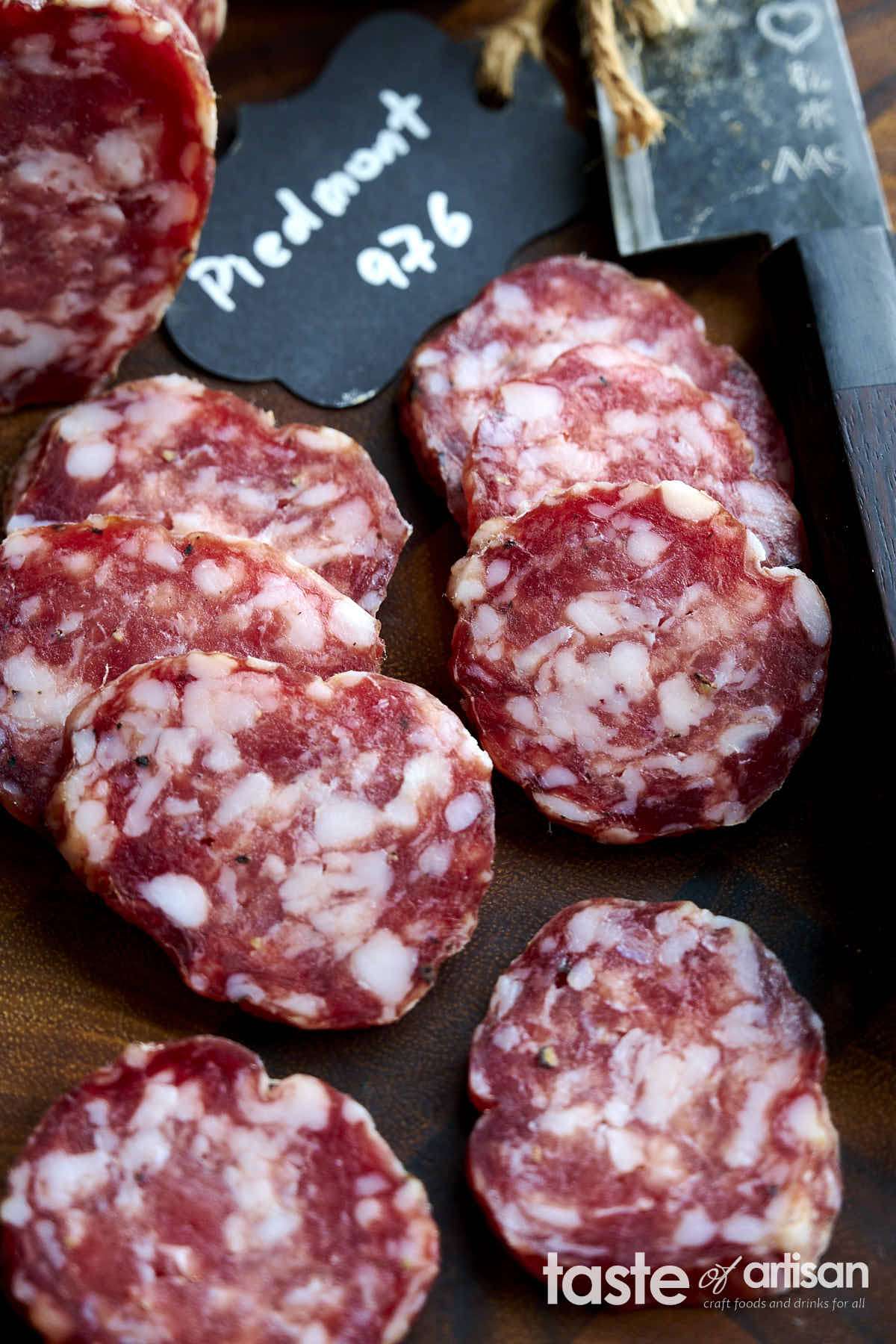
5.0 from 3 votes
Piedmont Salami (Salame Piemonte)
Perfect for any time of day, this recipe delivers great flavor effortlessly.
Prep Time
3 hrs
Additional Time
30 d
Total Time
30 d 3 hrs
Servings: 16 servings
Calories: 195 kcal
Course:
Main Course
Cuisine:
Italian
Ingredients
- 750 g lean pork from leg (ham), shoulder, or neck (coppa)
- 250 g pork fat from pork belly, jowl, or back fat
- 25.5 g sea salt
- 2.5 g Cure #2
- 2 g dextrose
- 2 g sugar
- 2 g coarsely ground black pepper or to taste, max 4 g
- 0.5 g nutmeg freshly ground
- 0.02 g cloves 0.02 g is a tiny amount that fits on the tip of a knife. Cloves go a long way to it's important to not add too much.
- 0.12 g T-SPX culture
- 20 ml red wine (preferably Piedmontese) min 2.5 ml
- 1/4 clove garlic pressed or crushed
- 60 ml Distilled Water
Instructions
- Crush or press the garlic and place it in a small cup. Add the wine and let it infuse for about 30-60 minutes. Strain the wine to remove the garlic.
- Rehydrate the starter culture in 60 ml of distilled water. (see notes)
- Weigh the lean meat and the pork belly/back fat in grams. Calculate the rest of the ingredients, except the distilled water, which may remain the same (see notes), weigh them out, and set aside.
- In a small bowl, combine the salt, Cure #2, sugar, dextrose, pepper, nutmeg, and cloves.
- Cut the lean meat into 2-inch pieces. Cut the fat into small cubes, about 3/4 - 1 inch.
- Freeze the meat and the fat for 30 minutes.
- Sprinkle the salt and seasoning mixture over the meat and fat and mix so it is evenly distributed.
- Grind through a 3/8″ (10 mm) grinder plate.
- Combine ground pork with the rehydrated starter culture and strained red wine. Mix well until sticky, and the characteristic elongated shape of the fat pieces is obtained. It helps to use a stand mixer with a paddle attachment or a meat mixer.
- Stuff into 40-90 mm natural casings and tie with twine.
- Using a sterilized needle or sausage pricker, prick holes across the entire salami.
- Weigh the salami, write down its weight on a tag and attach the tag to the salami.
- If desired, inoculate with (penicillium nalgiovense, penicillium salamii) mold.
- Use the leftover meat from the stuffer/stuffing tube to make a small sample for measuring the initial pH and the pH at later stages. Make sure to record the readings.
- Ferment and dry at 59F - 75F (15C - 25C) and 65% - 86% RH for a period of 7 days as per the drying protocol in the notes. Measure the pH; it should be below 5.3 at this point.
- Mature in the curing chamber at 55F - 57F (13C - 14C) and 75-78% RH for about 1-3 months, depending on the diameter of the salami, until 35% weight loss is obtained.
Cup of Yum
Alternative Fermentation/Curing Method
- Ferment salami at around 70-72F for three days to get the pH below 5.3.
- Cure at the standard 55F-57F and 75-78% RH until 35% weight loss is obtained.
Notes
- When scaling the recipe up, increase the starter culture accordingly, but keep the amount of water at 60 ml. Double water if you go over 3 kg of meat. As always, if the meat mix feels too stiff to mix properly and stuff, add more water as needed.
- For drying my salami (60-70mm), I used the following schedule:
Nutrition Information
Calories
195kcal
(10%)
Carbohydrates
0.4g
(0%)
Protein
10g
(20%)
Fat
17g
(26%)
Saturated Fat
6g
(30%)
Polyunsaturated Fat
2g
Monounsaturated Fat
7g
Trans Fat
0.01g
Cholesterol
45mg
(15%)
Sodium
703mg
(29%)
Potassium
191mg
(5%)
Fiber
0.04g
(0%)
Sugar
0.3g
(1%)
Vitamin A
1IU
(0%)
Vitamin C
0.02mg
(0%)
Calcium
4mg
(0%)
Iron
0.5mg
(3%)
Nutrition Facts
Serving: 16servings
Amount Per Serving
Calories 195
% Daily Value*
| Calories | 195kcal | 10% |
| Carbohydrates | 0.4g | 0% |
| Protein | 10g | 20% |
| Fat | 17g | 26% |
| Saturated Fat | 6g | 30% |
| Polyunsaturated Fat | 2g | 12% |
| Monounsaturated Fat | 7g | 35% |
| Trans Fat | 0.01g | 1% |
| Cholesterol | 45mg | 15% |
| Sodium | 703mg | 29% |
| Potassium | 191mg | 4% |
| Fiber | 0.04g | 0% |
| Sugar | 0.3g | 1% |
| Vitamin A | 1IU | 0% |
| Vitamin C | 0.02mg | 0% |
| Calcium | 4mg | 0% |
| Iron | 0.5mg | 3% |
* Percent Daily Values are based on a 2,000 calorie diet.